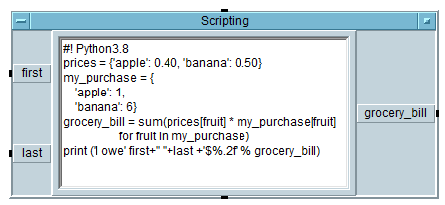
The purpose of this project is to provide a scripting object that allows external scripting languages to be incorporated in VEE programs. As with the Matlab Object, the Scripting object accepts arbitrary inputs and outputs and provides an editor for scripts. Unlike the Matlab object this can accept scripts in any supported language, as selected by a leading shebang.

There are various ways in which this may be accomplished.
It seems very likely that this project will come down to choosing between options 3 and 4, which would be a choice between elegance and (maybe) functionality. Or perhaps both methods can be implemented since there will be a major overlap.
A suggested architecture would allow for utilization in other environments.
Communicating between VEE and Python
In any scenario it is necessary to pass data back and forth between VEE and
Python
What version of Python should we use?
Packaging the embeddable server
It is perfectly fair and expected to ask "WHY?" do we need such a thing in the first place. The short answer is to extend the capabilities of VEE by providing a link to the modern world.
The math libraries in VEE date back to the late 1980's. While they were leading-edge at that time they have not been updated since are are showing their age. The existing libraries are 32-bit. Only a few accept complex arguments. Today there are a vast array of pure math, scientific, and engineering libraries available to be used- but no suitable link exists in VEE.
As it stands, VEE allows the import of libraries written in VEE or that have straight C interfaces via the Import Library object.

This capability allows the end user to transparently use the imported functions along side all the built-in functions. They show up in the Function Browser and can be used as desired in any expression, such as in the formula object

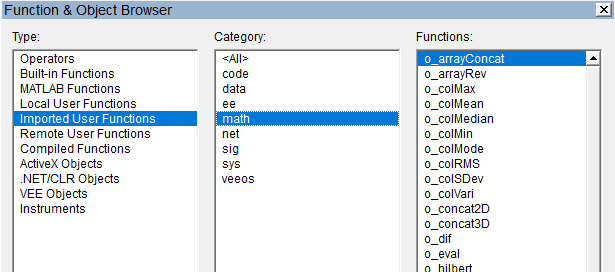
However this capability is limited to function written in VEE or whose import is available through a straight C interface. While straight C was common in the past, most modern libraries and tools do not provide such an interface. In some cases dotNet is available and can be used, but it tends to be clumsy and poorly documented.
To address this basic limitation and provide access to a broad range of functionality the MATLAB Object was introduced.

The Matlab Object provides a clean link to Matlab and hence to the broad array of Matlab libraries. In function it behaves just like a Formula object except that the expression (script) is interpreted by Matlab rather than the internal VEE engine.
Since the modern world has largely moved from compiled tools (C#, etc) to interpreted tools ( Python, etc) it becomes highly desirable to develop a more general purpose link to scripting, but while maintaining the ease of use of the Matlab Script object.
Implement any needed interface directly in VEE. For each scripting environment create a Toolkit, perhaps similar to the Excel or Database Toolkits.
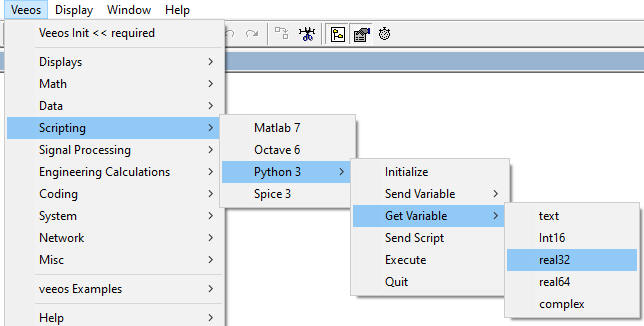
The end user would string together the needed tools for each supported scripting language. It seems likely that in each case there would be similar needed functions such as
This would almost certainly succeed since all that is needed is to implement whatever API each scripting language has available. Like addons such as VEEOS, this Toolkit could be added to the menus. Since this method requires no changes to VEE itself it can be implemented by a third-party. An example is the Excel tookit.
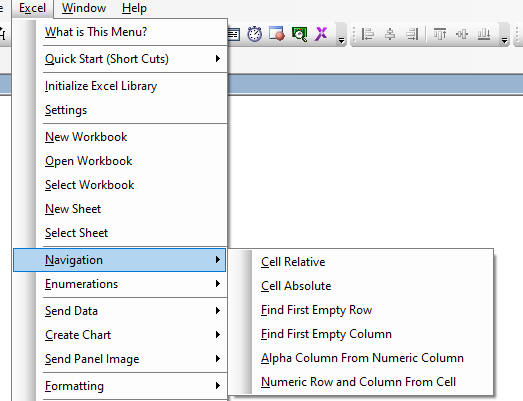
However, like these addons are a programming aid and the end user faces the significant task of understanding the needed details which are likely different for each supported language. The usage model would be very different from Matlab Object wherein no VEE programming is needed- just specify the script and variables.
This is likely the lowest risk and easiest to implement from a VEE perspective, but also the clumsiest in that it leaves many programming details to the end user.
Disadvantages
Create an intermediary function or set of functions within VEE that communicates with scripting languages.
The underlying functionality is provided by a function that hides the scripting Toolkit created for the Toolkit method. The end user sees this function instead of having to deal with the various pieces of the Toolkit.
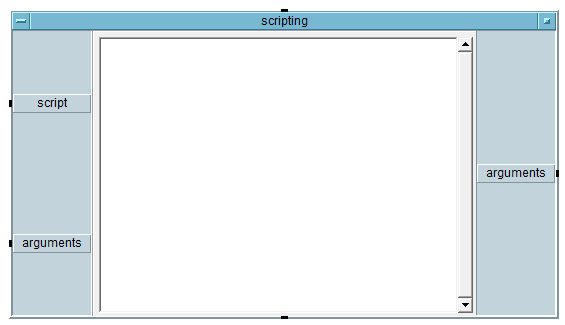
NOTE that since the function has exactly one input and one output for variables, if multiple variables are needed (probably most cases) they would need to be a single data structure. To do this it would make sense to use a record and have the variables be identified as field names with the accompanying values be of course the field values.
Record example- define two variables "A" and "B" (Record (schema (numFields 2) (fieldName "A" (type Text) ) (fieldName "B" (type Real64) ) ) (data (record ( "A" "Text field") ( "B" 1.25) ) ) )
Similarly, return variables would be part of the same input data structure, with dummy values as appropriate.
INPUT ################# (Record (schema (numFields 3) (fieldName "A" (type Text) ) (fieldName "B" (type Real64) ) (fieldName "X" (type Text) ) ) (data (record ( "A" "Text field") ( "B" 1.25) ( "X" "dummy value") ) ) ) OUTPUT ################## (Record ... ( "X" "calculated value") ) ) )This could be implemented with any version of VEE and with no internal VEE knowledge. Hence it is very low risk and mostly requires only knowledge of whatever language in which the handler is written. The handler function would examine the input record for variable names and values and then call the required Toolkit functions for the appropriate scripting language.
UPDATE: 20210220 -- initial version built using File IO and portable Python is successful. This is the least sophisticated handler and is slow but it works and should be fairly robust.
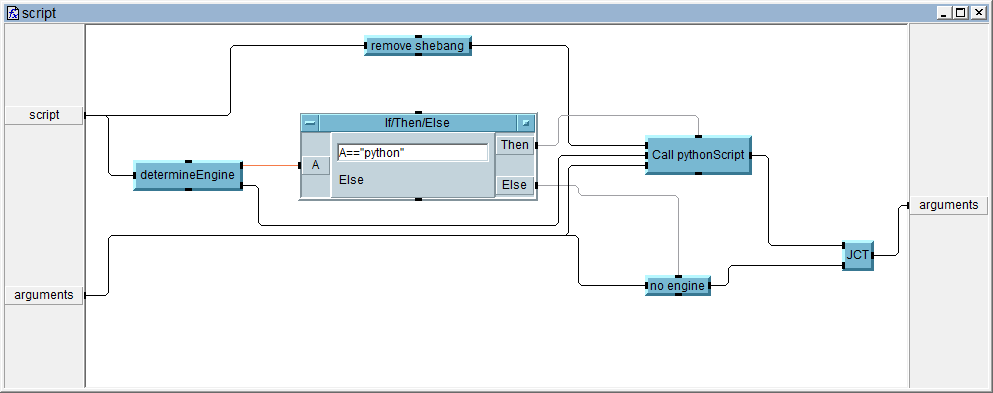
define variables
a = 45
B = 16
actual script
B= a + 2 * B
write variables to files
f = open("a", "w")
f.write(str(a))
f.close()
f = open("B", "w")
f.write(str(B))
f.close()
quit python
exit
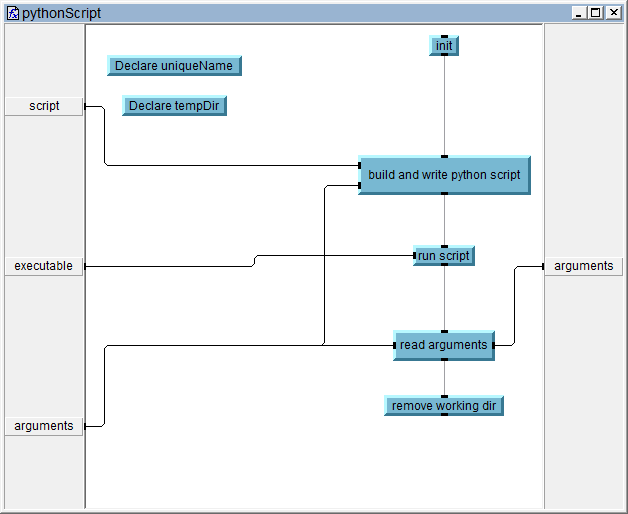
Profiling shows that, not surprisingly, the time sinks are writing files and especially instantiating and running Python. BUT at the same time this method works and shows feasibility.
The next step in complexity is to maintain the same structure but instead of using file IO, look at embedded Python. The advantage here will be performance since one should be able to instantiate Python and leave it running, calling functions as needed. Odds are a C wrapper would be involved to create a DLL that can be referenced as a Compiled Library.
Write an external handler that communicates with scripting languages and with VEE. VEE data and scripts are sent as VEE containers. The handler parses the containers, formats the script and data as needed, a executes the appropriate scripting language, then passes data back to VEE. By choosing an external language that is well supported and widely used, the task of incorporating new scripting engines could be made fairly simple.
The underlying functionality is provided by a function.

Scalar complex ########################## (Complex (data (34, -56)) ) Real64 array ############################ (Real64 (numDims 1) (size 3) (data [ 0.001251220703125 0.563568115234375 0.19329833984375 ] ) )
NOTE that since the function has exactly one input and one output, if multiple variables are needed (probably most cases) they would need to be a single data structure. To do this it would make sense to have the variables be identified as field names with the accompanying values be of course the field values.
Record example- define two variables "A" and "B" (Record (schema (numFields 2) (fieldName "A" (type Text) ) (fieldName "B" (type Real64) ) ) (data (record ( "A" "Text field") ( "B" 1.25) ) ) )
Similarly, return variables would be part of the same input data structure, with dummy values as appropriate.
INPUT ################# (Record (schema (numFields 3) (fieldName "A" (type Text) ) (fieldName "B" (type Real64) ) (fieldName "X" (type Text) ) ) (data (record ( "A" "Text field") ( "B" 1.25) ( "X" "dummy value") ) ) ) OUTPUT ################## (Record ... ( "X" "calculated value") ) ) )This could be implemented with any version of VEE and with no internal VEE knowledge. Hence it is very low risk and mostly requires only knowledge of whatever language in which the handler is written.
NOTE that if one had sufficient knowledge of VEE data structures it should be possible to pass data by reference instead of container format. However the reverse-engineering needed is significant and may not be worth the trouble compared to using container format.
The primary advantage of this method would be in the great support and widespread usage of Python. Once the data is in python ( variables and the script to run) there are likely tools already developed to link with Octave, Matlab, Spice and all sorts of other tools.
Conceptual Implementation:
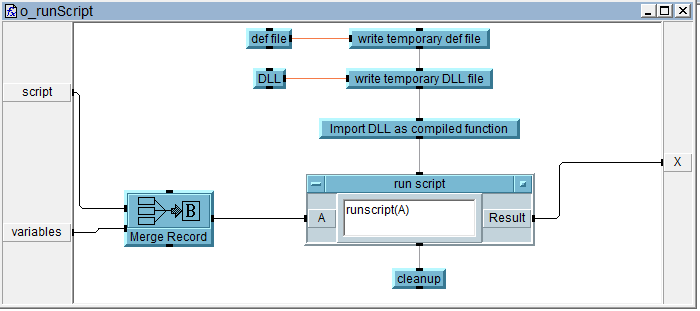
NOTE that the script is already text and the variables become text also when written as a record, so what likely makes sense for this method is to combine both into a single record, as in
(Record
(schema
(numFields 3)
(fieldName "script"
(type Text)
(numDims 1)
(size 8)
)
(fieldName "A"
(type Real32)
)
(fieldName "B"
(type Real32)
)
)
(data
(record
( "script"
[ "#! Python" "prices={\'apple\':A,\'banana\':B}" "my_purchase={" " \'apple\':1," " \'banana\':6}" "grocery_bill = sum (prices[fruit]*my_purchase[fruit]" " for fruit in my_purchase)" "print(\'I owe\'first+\" \"+last+\'$%.2f % grocery_bill)" ]
)
( "A" 0.4000000059604645)
( "B" 0.6000000238418579)
)
)
)
AND while this multi-line form is the default and is nicely human readable, it
likely makes more sense to remove the EOL's and make this a single string. That's
likely easier for parsing and is also appropriate as a single function argument.
On the VEE side either form works fine.
(Record (schema (numFields 3) (fieldName "script" (type Text) (numDims 1) (size 8) ) (fieldName "A" (type Real32) ) (fieldName "B" (type Real32) ) ) (data (record ( "script" [ "#! Python" "prices={\'apple\':A,\'banana\':B}" "my_purchase={" " \'apple\':1," " \'banana\':6}" "grocery_bill = sum (prices[fruit]*my_purchase[fruit]" " for fruit in my_purchase)" "print(\'I owe\'first+\" \"+last+\'$%.2f % grocery_bill)" ] ) ( "A" 0.4000000059604645) ( "B" 0.6000000238418579) )))
Note that the record container format is very regular, but will ant to look at all the cases except (probably) waveform and spectrum. Accordingly a simple VEE program is provided that writes a record with all datatypes to a file, but with (human readable) and without (more easily parsed?) EOL. These examples have Scalar,1D and 2D arrays.
NOTE that the ideal here may be to pass the entire record with both script and variables as a single string, but return just the variables. Probably best to do all the real work in python and have the C code do little more than just pass strings. It is likely feasible to write the DLL in Python also but since that needs to include the Python engine it would likely be a very large DLL compared to a few lines of C code. As noted earlier a very small DLL is desirable since it can easily be placed inside of VEE.
WHEN WRITING the container format will want to be sure and place the needed white space - primarily between words and before/after brackets. Extra whitespace is OK.
A possible follow-on would be to integrate a simple script-savvy text editor into VEE and present that on the face of a runScript UO.
ADVANTAGES of this method include
A handler provides a spoofed version of the Matlab interface and VEE preferences are set to use this interface. In VEE the Matlab Object becomes a general Script object but is otherwise exactly the same. For the end user this becomes extremely clean and simple since it works exactly like the native Matlab object. The user becomes free to add any inputs and outputs desired. For backward compatibility also need to be able to call both the OEM Matlab and full Matlab from the spoof and Matlab should be default engine.

With VEE 7 the interface is a simple set of COM functions that are imported when the Matlab object is run. Note that when VEE is first installed this library is not registered, but it is registered when the Matlab object is first run.
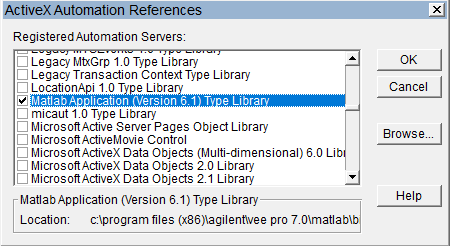
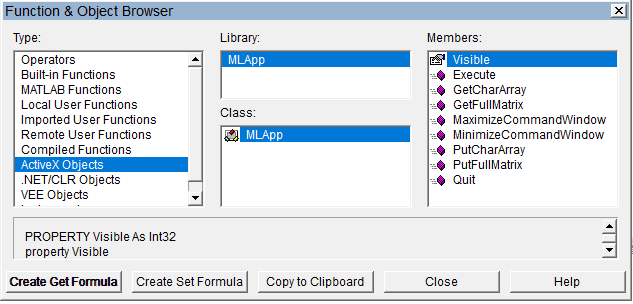
There would still need to be a handler that determines which script engine to run and handles communications.
What is needed along with a handler is the spoofed interface
It is quickly seen that there is NOT an obvious load of external libraries as with VEE 7. Digging further shows that even a full install of Matlab does not register any useful-looking libraries. However the link is established somehow and is almost certainly a function library of some sort.
Firing up the internal Matlab that comes with VEE and looking at the attached DLL's (procexp) shows quite a fewawt.dll Java(TM) Platform SE binary Sun Microsystems, Inc. C:\Program Files (x86)\Keysight\VEE Pro 9.3\matlab\sys\java\jre\win32\jre\bin\awt.dll boost_date_time-vc90-mt-1_40.dll C:\Program Files (x86)\Keysight\VEE Pro 9.3\matlab\bin\win32\boost_date_time-vc90-mt-1_40.dll boost_filesystem-vc90-mt-1_40.dll C:\Program Files (x86)\Keysight\VEE Pro 9.3\matlab\bin\win32\boost_filesystem-vc90-mt-1_40.dll boost_iostreams-vc90-mt-1_40.dll C:\Program Files (x86)\Keysight\VEE Pro 9.3\matlab\bin\win32\boost_iostreams-vc90-mt-1_40.dll boost_regex-vc90-mt-1_40.dll C:\Program Files (x86)\Keysight\VEE Pro 9.3\matlab\bin\win32\boost_regex-vc90-mt-1_40.dll boost_signals-vc90-mt-1_40.dll C:\Program Files (x86)\Keysight\VEE Pro 9.3\matlab\bin\win32\boost_signals-vc90-mt-1_40.dll boost_system-vc90-mt-1_40.dll C:\Program Files (x86)\Keysight\VEE Pro 9.3\matlab\bin\win32\boost_system-vc90-mt-1_40.dll boost_thread-vc90-mt-1_40.dll C:\Program Files (x86)\Keysight\VEE Pro 9.3\matlab\bin\win32\boost_thread-vc90-mt-1_40.dll comcli.dll comcli The MathWorks Inc. C:\Program Files (x86)\Keysight\VEE Pro 9.3\matlab\bin\win32\comcli.dll ctfarchiver.dll C:\Program Files (x86)\Keysight\VEE Pro 9.3\matlab\bin\win32\ctfarchiver.dll ctfrt.dll C:\Program Files (x86)\Keysight\VEE Pro 9.3\matlab\bin\win32\ctfrt.dll ctfrtcrypto.dll ctfrtcrypto The MathWorks Inc. C:\Program Files (x86)\Keysight\VEE Pro 9.3\matlab\bin\win32\ctfrtcrypto.dll dservices.dll C:\Program Files (x86)\Keysight\VEE Pro 9.3\matlab\bin\win32\dservices.dll fontmanager.dll Java(TM) Platform SE binary Sun Microsystems, Inc. C:\Program Files (x86)\Keysight\VEE Pro 9.3\matlab\sys\java\jre\win32\jre\bin\fontmanager.dll graphics_util.dll C:\Program Files (x86)\Keysight\VEE Pro 9.3\matlab\bin\win32\graphics_util.dll hg.dll hg The MathWorks Inc. C:\Program Files (x86)\Keysight\VEE Pro 9.3\matlab\bin\win32\hg.dll hgbuiltins.dll C:\Program Files (x86)\Keysight\VEE Pro 9.3\matlab\bin\win32\hgbuiltins.dll hgdatatypes.dll C:\Program Files (x86)\Keysight\VEE Pro 9.3\matlab\bin\win32\hgdatatypes.dll hgutils.dll C:\Program Files (x86)\Keysight\VEE Pro 9.3\matlab\bin\win32\hgutils.dll hpi.dll Java(TM) Platform SE binary Sun Microsystems, Inc. C:\Program Files (x86)\Keysight\VEE Pro 9.3\matlab\sys\java\jre\win32\jre\bin\hpi.dll icudt42.dll ICU Data DLL IBM Corporation and others C:\Program Files (x86)\Keysight\VEE Pro 9.3\matlab\bin\win32\icudt42.dll icuin42.dll IBM ICU I18N DLL IBM Corporation and others C:\Program Files (x86)\Keysight\VEE Pro 9.3\matlab\bin\win32\icuin42.dll icuio42.dll IBM ICU I/O DLL IBM Corporation and others C:\Program Files (x86)\Keysight\VEE Pro 9.3\matlab\bin\win32\icuio42.dll icuuc42.dll IBM ICU Common DLL IBM Corporation and others C:\Program Files (x86)\Keysight\VEE Pro 9.3\matlab\bin\win32\icuuc42.dll iqm.dll C:\Program Files (x86)\Keysight\VEE Pro 9.3\matlab\bin\win32\iqm.dll ir_xfmr.dll C:\Program Files (x86)\Keysight\VEE Pro 9.3\matlab\bin\win32\ir_xfmr.dll java.dll Java(TM) Platform SE binary Sun Microsystems, Inc. C:\Program Files (x86)\Keysight\VEE Pro 9.3\matlab\sys\java\jre\win32\jre\bin\java.dll jmi.dll jmi The MathWorks Inc. C:\Program Files (x86)\Keysight\VEE Pro 9.3\matlab\bin\win32\jmi.dll jproxy.dll C:\Program Files (x86)\Keysight\VEE Pro 9.3\matlab\bin\win32\jproxy.dll jvm.dll Java HotSpot(TM) Client VM Sun Microsystems, Inc. C:\Program Files (x86)\Keysight\VEE Pro 9.3\matlab\sys\java\jre\win32\jre\bin\client\jvm.dll libexpat.dll C:\Program Files (x86)\Keysight\VEE Pro 9.3\matlab\bin\win32\libexpat.dll libhdf5.dll C:\Program Files (x86)\Keysight\VEE Pro 9.3\matlab\bin\win32\libhdf5.dll libifcoremd.dll Intel(r) Fortran Compiler RTL (thread-safe) Intel Corporation C:\Program Files (x86)\Keysight\VEE Pro 9.3\matlab\bin\win32\libifcoremd.dll libmat.dll libmat The MathWorks Inc. C:\Program Files (x86)\Keysight\VEE Pro 9.3\matlab\bin\win32\libmat.dll libmex.dll libmex The MathWorks Inc. C:\Program Files (x86)\Keysight\VEE Pro 9.3\matlab\bin\win32\libmex.dll libmmd.dll Math Library for Intel(r) Compilers (thread-safe) Intel Corporation C:\Program Files (x86)\Keysight\VEE Pro 9.3\matlab\bin\win32\libmmd.dll libmwamd.dll C:\Program Files (x86)\Keysight\VEE Pro 9.3\matlab\bin\win32\libmwamd.dll libmwbinder.dll C:\Program Files (x86)\Keysight\VEE Pro 9.3\matlab\bin\win32\libmwbinder.dll libmwblas.dll C:\Program Files (x86)\Keysight\VEE Pro 9.3\matlab\bin\win32\libmwblas.dll libmwbridge.dll C:\Program Files (x86)\Keysight\VEE Pro 9.3\matlab\bin\win32\libmwbridge.dll libmwbuiltins.dll libmwbuiltins The MathWorks Inc. C:\Program Files (x86)\Keysight\VEE Pro 9.3\matlab\bin\win32\libmwbuiltins.dll libmwcholmod.dll C:\Program Files (x86)\Keysight\VEE Pro 9.3\matlab\bin\win32\libmwcholmod.dll libmwcolamd.dll C:\Program Files (x86)\Keysight\VEE Pro 9.3\matlab\bin\win32\libmwcolamd.dll libmwcsparse.dll C:\Program Files (x86)\Keysight\VEE Pro 9.3\matlab\bin\win32\libmwcsparse.dll libmwfl.dll C:\Program Files (x86)\Keysight\VEE Pro 9.3\matlab\bin\win32\libmwfl.dll libmwgui.dll gui The MathWorks Inc. C:\Program Files (x86)\Keysight\VEE Pro 9.3\matlab\bin\win32\libmwgui.dll libmwhardcopy.dll hardcopy The MathWorks Inc. C:\Program Files (x86)\Keysight\VEE Pro 9.3\matlab\bin\win32\libmwhardcopy.dll libmwi18n.dll C:\Program Files (x86)\Keysight\VEE Pro 9.3\matlab\bin\win32\libmwi18n.dll libmwlapack.dll C:\Program Files (x86)\Keysight\VEE Pro 9.3\matlab\bin\win32\libmwlapack.dll libmwma57.dll C:\Program Files (x86)\Keysight\VEE Pro 9.3\matlab\bin\win32\libmwma57.dll libmwmathcore.dll mathcore The MathWorks Inc. C:\Program Files (x86)\Keysight\VEE Pro 9.3\matlab\bin\win32\libmwmathcore.dll libmwmathelem.dll mathelem The MathWorks Inc. C:\Program Files (x86)\Keysight\VEE Pro 9.3\matlab\bin\win32\libmwmathelem.dll libmwmathlinalg.dll mathlinalg The MathWorks Inc. C:\Program Files (x86)\Keysight\VEE Pro 9.3\matlab\bin\win32\libmwmathlinalg.dll libmwmathrng.dll C:\Program Files (x86)\Keysight\VEE Pro 9.3\matlab\bin\win32\libmwmathrng.dll libmwmathutil.dll C:\Program Files (x86)\Keysight\VEE Pro 9.3\matlab\bin\win32\libmwmathutil.dll libmwmathxps.dll C:\Program Files (x86)\Keysight\VEE Pro 9.3\matlab\bin\win32\libmwmathxps.dll libmwMATLAB_res.dll C:\Program Files (x86)\Keysight\VEE Pro 9.3\matlab\bin\win32\libmwMATLAB_res.dll libmwompwrapper.dll C:\Program Files (x86)\Keysight\VEE Pro 9.3\matlab\bin\win32\libmwompwrapper.dll libmwresource_core.dll C:\Program Files (x86)\Keysight\VEE Pro 9.3\matlab\bin\win32\libmwresource_core.dll libmwrookfastbp.dll C:\Program Files (x86)\Keysight\VEE Pro 9.3\matlab\bin\win32\libmwrookfastbp.dll libmwservices.dll libmwservices The MathWorks Inc. C:\Program Files (x86)\Keysight\VEE Pro 9.3\matlab\bin\win32\libmwservices.dll libmwspmatrix.dll C:\Program Files (x86)\Keysight\VEE Pro 9.3\matlab\bin\win32\libmwspmatrix.dll libmwspqr.dll C:\Program Files (x86)\Keysight\VEE Pro 9.3\matlab\bin\win32\libmwspqr.dll libmwumfpack.dll C:\Program Files (x86)\Keysight\VEE Pro 9.3\matlab\bin\win32\libmwumfpack.dll libmx.dll libmx The MathWorks Inc. C:\Program Files (x86)\Keysight\VEE Pro 9.3\matlab\bin\win32\libmx.dll libuij.dll libuij The MathWorks Inc. C:\Program Files (x86)\Keysight\VEE Pro 9.3\matlab\bin\win32\libuij.dll libut.dll libut The MathWorks Inc. C:\Program Files (x86)\Keysight\VEE Pro 9.3\matlab\bin\win32\libut.dll m_dispatcher.dll C:\Program Files (x86)\Keysight\VEE Pro 9.3\matlab\bin\win32\m_dispatcher.dll m_interpreter.dll m_interpreter The MathWorks Inc. C:\Program Files (x86)\Keysight\VEE Pro 9.3\matlab\bin\win32\m_interpreter.dll m_ir.dll m_ir The MathWorks Inc. C:\Program Files (x86)\Keysight\VEE Pro 9.3\matlab\bin\win32\m_ir.dll m_parser.dll m_parser The MathWorks Inc. C:\Program Files (x86)\Keysight\VEE Pro 9.3\matlab\bin\win32\m_parser.dll m_pcodegen.dll m_pcodegen The MathWorks Inc. C:\Program Files (x86)\Keysight\VEE Pro 9.3\matlab\bin\win32\m_pcodegen.dll m_pcodeio.dll m_pcodeio The MathWorks Inc. C:\Program Files (x86)\Keysight\VEE Pro 9.3\matlab\bin\win32\m_pcodeio.dll mclbase.dll C:\Program Files (x86)\Keysight\VEE Pro 9.3\matlab\bin\win32\mclbase.dll mclmcr.dll C:\Program Files (x86)\Keysight\VEE Pro 9.3\matlab\bin\win32\mclmcr.dll mclmcrrt7_15.dll C:\Program Files (x86)\Keysight\VEE Pro 9.3\matlab\runtime\win32\mclmcrrt7_15.dll mcos.dll C:\Program Files (x86)\Keysight\VEE Pro 9.3\matlab\bin\win32\mcos.dll mcr.dll mcr The MathWorks Inc. C:\Program Files (x86)\Keysight\VEE Pro 9.3\matlab\bin\win32\mcr.dll mlautoregister.dll mlautoregister The MathWorks Inc. C:\Program Files (x86)\Keysight\VEE Pro 9.3\matlab\bin\win32\mlautoregister.dll mlint.dll C:\Program Files (x86)\Keysight\VEE Pro 9.3\matlab\bin\win32\mlint.dll mlutil.dll C:\Program Files (x86)\Keysight\VEE Pro 9.3\matlab\bin\win32\mlutil.dll mpath.dll mpath The MathWorks Inc. C:\Program Files (x86)\Keysight\VEE Pro 9.3\matlab\bin\win32\mpath.dll msvcr71.dll Microsoft® C Runtime Library Microsoft Corporation C:\Program Files (x86)\Keysight\VEE Pro 9.3\matlab\bin\win32\msvcr71.dll mtok.dll C:\Program Files (x86)\Keysight\VEE Pro 9.3\matlab\bin\win32\mtok.dll mvm.dll C:\Program Files (x86)\Keysight\VEE Pro 9.3\matlab\bin\win32\mvm.dll mwoles05.dll MATLAB Automation Server The MathWorks C:\Program Files (x86)\Keysight\VEE Pro 9.3\matlab\bin\win32\mwoles05.dll nativehg.dll C:\Program Files (x86)\Keysight\VEE Pro 9.3\matlab\bin\win32\nativehg.dll nativejava.dll C:\Program Files (x86)\Keysight\VEE Pro 9.3\matlab\bin\win32\nativejava.dll nativejava_services.dll C:\Program Files (x86)\Keysight\VEE Pro 9.3\matlab\bin\win32\nativejava_services.dll nativejmi.dll C:\Program Files (x86)\Keysight\VEE Pro 9.3\matlab\bin\win32\nativejmi.dll nativeservices.dll C:\Program Files (x86)\Keysight\VEE Pro 9.3\matlab\bin\win32\nativeservices.dll net.dll Java(TM) Platform SE binary Sun Microsystems, Inc. C:\Program Files (x86)\Keysight\VEE Pro 9.3\matlab\sys\java\jre\win32\jre\bin\net.dll nio.dll Java(TM) Platform SE binary Sun Microsystems, Inc. C:\Program Files (x86)\Keysight\VEE Pro 9.3\matlab\sys\java\jre\win32\jre\bin\nio.dll profiler.dll C:\Program Files (x86)\Keysight\VEE Pro 9.3\matlab\bin\win32\profiler.dll tbb.dll Threading Building Blocks library Intel Corporation C:\Program Files (x86)\Keysight\VEE Pro 9.3\matlab\bin\win32\tbb.dll tbbmalloc.dll Scalable Allocator library Intel Corporation C:\Program Files (x86)\Keysight\VEE Pro 9.3\matlab\bin\win32\tbbmalloc.dll udd.dll udd The MathWorks Inc. C:\Program Files (x86)\Keysight\VEE Pro 9.3\matlab\bin\win32\udd.dll udd_mi.dll udd_mi The MathWorks Inc. C:\Program Files (x86)\Keysight\VEE Pro 9.3\matlab\bin\win32\udd_mi.dll uinone.dll C:\Program Files (x86)\Keysight\VEE Pro 9.3\matlab\bin\win32\uinone.dll uiw.dll uiw The MathWorks Inc. C:\Program Files (x86)\Keysight\VEE Pro 9.3\matlab\bin\win32\uiw.dll verify.dll Java(TM) Platform SE binary Sun Microsystems, Inc. C:\Program Files (x86)\Keysight\VEE Pro 9.3\matlab\sys\java\jre\win32\jre\bin\verify.dll xerces-c_2_7.dll Shared Library for Xerces-C Version 2.7.0 Apache Software Foundation C:\Program Files (x86)\Keysight\VEE Pro 9.3\matlab\bin\win32\xerces-c_2_7.dll xmlcore.dll C:\Program Files (x86)\Keysight\VEE Pro 9.3\matlab\bin\win32\xmlcore.dll xsd_binder.dll C:\Program Files (x86)\Keysight\VEE Pro 9.3\matlab\bin\win32\xsd_binder.dll zip.dll Java(TM) Platform SE binary Sun Microsystems, Inc. C:\Program Files (x86)\Keysight\VEE Pro 9.3\matlab\sys\java\jre\win32\jre\bin\zip.dll zlib1.dll zlib data compression library C:\Program Files (x86)\Keysight\VEE Pro 9.3\matlab\bin\win32\zlib1.dllA full Matlab install (NOTE that one needs 32-bit version) includes a large number of DLL's
acml.dll activation.dll asynciocore.dll asyncioimpl.dll boost_date_time-vc90-mt-1_40.dll boost_filesystem-vc90-mt-1_40.dll boost_graph-vc90-mt-1_40.dll boost_iostreams-vc90-mt-1_40.dll boost_math_c99-vc90-mt-1_40.dll boost_math_c99f-vc90-mt-1_40.dll boost_math_c99l-vc90-mt-1_40.dll boost_math_tr1-vc90-mt-1_40.dll boost_math_tr1f-vc90-mt-1_40.dll boost_math_tr1l-vc90-mt-1_40.dll boost_prg_exec_monitor-vc90-mt-1_40.dll boost_program_options-vc90-mt-1_40.dll boost_regex-vc90-mt-1_40.dll boost_serialization-vc90-mt-1_40.dll boost_signals-vc90-mt-1_40.dll boost_system-vc90-mt-1_40.dll boost_thread-vc90-mt-1_40.dll boost_unit_test_framework-vc90-mt-1_40.dll boost_wave-vc90-mt-1_40.dll boost_wserialization-vc90-mt-1_40.dll comcli.dll dastudio.dll dastudio_hg.dll dirmonitor.dll dotnetcli.dll dotnetcli_loader.dll DXEnumerator.dll EasyHook32.dll emf.dll glee.dll glee2.dll glee2_mi.dll glee2_qt.dll glee_util.dll glren.dll gluegen-rt.dll gmp.dll graphics_util.dll gsdll32.dll handle_graphics.dll hd424m.dll hg.dll hgbuiltins.dll hgdatatypes.dll hgutils.dll hm424m.dll icudt42.dll icuin42.dll icuio42.dll icule42.dll icuuc42.dll instutil.dll iqm.dll ir_interp.dll ir_xfmr.dll JavaAccessBridge.dll JAWTAccessBridge.dll jmi.dll jogl.dll jogl_awt.dll Jp2Adapter.dll kdu_a63R.dll kdu_v63R.dll libaudiodevice.dll libcdf.dll libeng.dll libexpat.dll libfftw3.dll libfftw3f.dll libfftw3i.dll libGctp.dll libhdf5.dll libhdf5_hl.dll libhdfeos.dll libifcoremd.dll libifportmd.dll libiomp5md.dll libmat.dll libmex.dll libmmd.dll libmwamd.dll libmwarpack.dll libmwbinder.dll libmwblas.dll libmwblascompat32.dll libmwbridge.dll libmwbuiltins.dll libmwchart.dll libmwcholmod.dll libmwcli.dll libmwcolamd.dll libmwcsparse.dll libmwdastudio_res.dll libmwfftw.dll libmwfl.dll libmwglee_res.dll libmwglue2_res.dll libmwgui.dll libmwhardcopy.dll libmwhghardcopy.dll libmwi18n.dll libmwlapack.dll libmwma57.dll libmwmathcgeo.dll libmwmathcore.dll libmwmathdsp.dll libmwmathelem.dll libmwmathlinalg.dll libmwmathrng.dll libmwmathspec.dll libmwmathutil.dll libmwmathxps.dll libmwMATLAB_res.dll libmwompwrapper.dll libmwqhull.dll libmwresource_core.dll libmwrookfastbp.dll libmwsavevars.dll libmwservices.dll libmwSimulinkTypes_res.dll libmwSL_SERVICES_res.dll libmwspmatrix.dll libmwspqr.dll libmwumfpack.dll libmx.dll libnetcdf.dll libpng12.dll libportaudio.dll libtiff.dll libuij.dll libut.dll m3i.dll m3i_mi.dll mcos.dll mcos_factory.dll mcr.dll mkl.dll mlautoregister.dll mlib.dll mlint.dll mllapack.dll mlutil.dll MMCodecChooser.dll mmreadercore.dll mmreaderudd.dll mpath.dll mpfr.dll msvcp71.dll msvcr71.dll mtok.dll multimedia.dll mvm.dll mwdx.dll mwoles05.dll m_dispatcher.dll m_interpreter.dll m_ir.dll m_parser.dll m_pcodegen.dll m_pcodeio.dll nativecmdwin.dll nativedirmonitor.dll nativehg.dll nativei18n.dll nativejava.dll nativejava_services.dll nativejmi.dll nativelex.dll nativelmgr.dll nativemat.dll nativemlint.dll nativeservices.dll nativewindows.dll osg65-osg.dll osg65-osgDB.dll osg65-osgFX.dll osg65-osgGA.dll osg65-osgManipulator.dll osg65-osgParticle.dll osg65-osgShadow.dll osg65-osgSim.dll osg65-osgTerrain.dll osg65-osgText.dll osg65-osgUtil.dll osg65-osgViewer.dll osgserver.dll ot11-OpenThreads.dll PreviewWindow.dll profiler.dll Qt3Support4.dll QtCore4.dll QtGui4.dll QtNetwork4.dll QtOpenGL4.dll QtSql4.dll QtSvg4.dll QtWebKit4.dll QtXml4.dll QtXmlPatterns4.dll refblas.dll reflapackpt.dll rxtxSerial.dll servicesproxy.dll sl_services.dll sl_types.dll sl_utility.dll tamimframe.dll tamimframemex.dll tammex.dll tamobjsys.dll tamutil.dll tbb.dll tbbmalloc.dll udd.dll udd_mi.dll uinone.dll uiw.dll VideoDeviceChooser.dll VideoFormatInfo.dll WindowsAccessBridge.dll xerces-c_2_7.dll xmlcore.dll xmlxrcsc.dll ziparchiver.dll zlib1.dllbut looking at what VEE attaches when it runs a script shows a relatively small number of DLL's. these would seem a good starting point seeing what is necessary for the spoof.
boost_date_time-vc90-mt-1_40.dll C:\apps\MATLAB\R2011a\bin\win32\boost_date_time-vc90-mt-1_40.dll boost_filesystem-vc90-mt-1_40.dll C:\apps\MATLAB\R2011a\bin\win32\boost_filesystem-vc90-mt-1_40.dll boost_signals-vc90-mt-1_40.dll C:\apps\MATLAB\R2011a\bin\win32\boost_signals-vc90-mt-1_40.dll boost_system-vc90-mt-1_40.dll C:\apps\MATLAB\R2011a\bin\win32\boost_system-vc90-mt-1_40.dll boost_thread-vc90-mt-1_40.dll C:\apps\MATLAB\R2011a\bin\win32\boost_thread-vc90-mt-1_40.dll icudt42.dll ICU Data DLL IBM Corporation and others C:\apps\MATLAB\R2011a\bin\win32\icudt42.dll icuin42.dll IBM ICU I18N DLL IBM Corporation and others C:\apps\MATLAB\R2011a\bin\win32\icuin42.dll icuio42.dll IBM ICU I/O DLL IBM Corporation and others C:\apps\MATLAB\R2011a\bin\win32\icuio42.dll icuuc42.dll IBM ICU Common DLL IBM Corporation and others C:\apps\MATLAB\R2011a\bin\win32\icuuc42.dll libeng.dll libeng The MathWorks Inc. C:\apps\MATLAB\R2011a\bin\win32\libeng.dll libexpat.dll C:\apps\MATLAB\R2011a\bin\win32\libexpat.dll libmwfl.dll C:\apps\MATLAB\R2011a\bin\win32\libmwfl.dll libmwi18n.dll C:\apps\MATLAB\R2011a\bin\win32\libmwi18n.dll libmwMATLAB_res.dll C:\apps\MATLAB\R2011a\bin\win32\libmwMATLAB_res.dll libmwresource_core.dll C:\apps\MATLAB\R2011a\bin\win32\libmwresource_core.dll libmx.dll libmx The MathWorks Inc. C:\apps\MATLAB\R2011a\bin\win32\libmx.dll libut.dll libut The MathWorks Inc. C:\apps\MATLAB\R2011a\bin\win32\libut.dll zlib1.dll zlib data compression library C:\apps\MATLAB\R2011a\bin\win32\zlib1.dll234A quick experiment shows that a real Matlab install is registered in


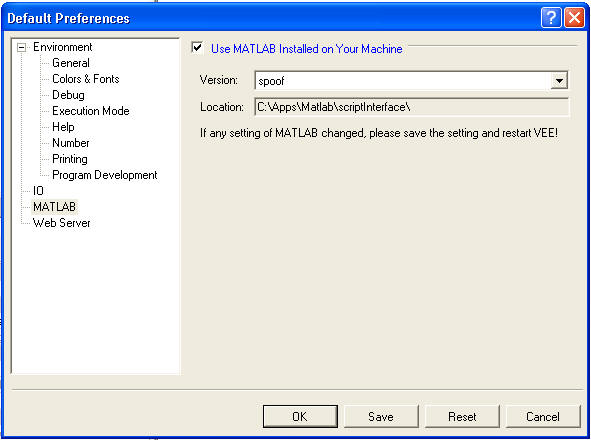
Windows Registry Editor Version 5.00 [HKEY_LOCAL_MACHINE\SOFTWARE\WOW6432Node\Mathworks] [HKEY_LOCAL_MACHINE\SOFTWARE\WOW6432Node\Mathworks\Matlab] [HKEY_LOCAL_MACHINE\SOFTWARE\WOW6432Node\Mathworks\Matlab\spoof] "MATLABROOT"="c:\\apps\\scriptInterface"VEE would then recognize and link to it. Note that an empty directory will not work, but all that is needed for the Default Preferences choice is a file <location>\bin\win32\MATLAB.exe. Note that this can be a dummy file. What's left is to look at what resources "MATLAB.exe" needs to have in order for VEE to link to it. Note that the real "MATLAB.exe" is a small file so almost certainly essentially a header. The real work is probably a script engine incorporating files such as mcr.dll. This will need to be determined for a successful spoof.
C and Fortran Engine Library Functions - 2015b engOpen (C and Fortran) Start MATLAB engine session engOpenSingleUse (C) Start MATLAB engine session for single, nonshared use engClose (C and Fortran) Quit MATLAB engine session Engine (C) Type for MATLAB engine engEvalString (C and Fortran) Evaluate expression in string engGetVariable (C and Fortran) Copy variable from MATLAB engine workspace engPutVariable (C and Fortran) Put variable into MATLAB engine workspace engGetVisible (C) Determine visibility of MATLAB engine session engSetVisible (C) Show or hide MATLAB engine session engOutputBuffer (C and Fortran) Specify buffer for MATLAB output
Fortunately Mathworks provides some nice examples to go along with this documentation. These examples are from R2011a which is the same vintage as VEE 9.3's OEM Matlab. If they match the 2015b documentation then that documentation should be valid for our work. An extract at one of the examples (endemo.c) indeed shows exactly the above functions.
if (!(ep = engOpen("\0"))) { fprintf(stderr, "\nCan't start MATLAB engine\n"); return EXIT_FAILURE; } /* * PART I * * For the first half of this demonstration, we will send data * to MATLAB, analyze the data, and plot the result. */ /* * Create a variable for our data */ T = mxCreateDoubleMatrix(1, 10, mxREAL); memcpy((void *)mxGetPr(T), (void *)time, sizeof(time)); /* * Place the variable T into the MATLAB workspace */ engPutVariable(ep, "T", T); /* * Evaluate a function of time, distance = (1/2)g.*t.^2 * (g is the acceleration due to gravity) */ engEvalString(ep, "D = .5.*(-9.8).*T.^2;"); /* * Plot the result */ engEvalString(ep, "plot(T,D);"); engEvalString(ep, "title('Position vs. Time for a falling object');"); engEvalString(ep, "xlabel('Time (seconds)');"); engEvalString(ep, "ylabel('Position (meters)');");
If this is indeed the case then the interface is very similar to what was used back in VEE 7, albeit with different functions. The Mathworks documentation gives a decent description of these functions so implementing a Python emulation may not be all that tough. It would of course be great to examine VEE source, but that is probably not possible, so experimentation will be needed, but at least the docs should greatly limit that exercise. The apparent process is exactly as with Matlab 7:
Going the other way- controlling Matlab from Python- appears fully documented so should be much easier.
ADVANTAGES of this method include
DISADVANTAGES other than the difficulty
As with any project like this it is important to start with a design rather than starting with the details. In this case after perusing the various needs we will want to settle on an architecture before digging in very far. From a very high level this is simple enough
But looking even slightly deeper shows needed architectural details such as:
The "proof of concept" code creates a final script that includes the original script, lines to create the needed data, and more lines to create the needed outputs. Then the full script is passed to Python and run as a batch job.
Conversely the Matlab engine method is much more serial in nature. The Matlab engine is started then one line at a time is passed to it, creating data, running the desired script, and then bringing data back. But everything is a single line of code at a time (engEvalString)
Our code will want to be able to accommodate either batch or serial mode on the backend (running external engines) and we will want to decide on a transfer mode when we are talking to VEE. In one scenario we would send all the data and script as a VEE container and the Python handler would go from there:
Given a structure something like this, some fairly obvious modules come to mind:
Given a multi-person team it seems reasonable to choose and IDE, define schemas, write up some external docs and then assign the various pieces to team members.
QUESTION: once we have the emulated Matlab can we call that directly as opposed to via the Matlab script object? if so then maybe can build UF which behaves like the script object but is programmable. Of course if that's our goal then why do the spoofing?
Use minimal Python engine for our server and treat full Python as a client. (9MAY2021)
This may seem convoluted but at the same time it solves multiple issues and sets up a simple way to expand in the future and to support network computation such as the image processing that Richard would like to do.
This approach stems from initial investigation by Faisal. In looking at the socket server he notes that since we allow the end user to specify arbitrary scripts to execute, there's nothing stopping those scripts from loading libraries or doing most anything else to our python install. We can't simply lock things down with permissions since the end user may fundamentally need to load new libraries or make other changes. It would seem that the core problem here is that in this scenario Python is acting as both server AND client. The server needs to be stable and controlled but the client needs to be open- and we really can't have both.
My suggested solution is to have a small dedicated python install (as in directly from python.org, adding only necessary libraries and removing anything not needed) for the server that is called by VEE. This server talks to VEE via sockets. Any "client" including python is controlled by this small server.
VEE <> Python server <> python
<> octave
<> SPICE
<> any other client which we can add as a plugin to our server
By doing this we have complicated things somewhat but have effectively separated the SERVER and CLIENT rolls. As for implementation details I expect that a small piece of any network computing Python library would do the trick just fine, then treat localhost as a network client. A real plus to using the network computing library would be that it would be very simple to place the end python on a server somewhere instead of on the user's machine. A side benefit is that since our server uses a minimal python engine it should start very quickly.
One such network computing choice might be RAY. It is overkill by quite a bit BUT at the same time it would certainly set us up well to support servers such as with Richard's image processing work.
Disadvantages
Advantages
This is a relatively small issue but one which we should carefully consider from the end user's point of view. It seems reasonable to adopt a similar use model as is presented with the VEE Matlab Script object. In that case a core set of Matlab (basically an engine plus signal processing library) is shipped with VEE. This is the default Matlab that is exercised by the Matlab Script object. This is transparent to the end user aside from the time lag instantiating the Matlab engine. This does not provide everything that Matlab can do but is a good solid subset and it is incorporated into the Function browser. However the end user can also install a full "real" Matlab and instruct the Matlab Script engine to instead use this installed Matlab. This way the Matlab Script object can exercise the full power of Matlab.
With Python we could do something similar fairly easily. The basic idea of the shebang line is that the end user can specify a script engine, so one way we could proceed would be
#! Python - uses the default version of Python that we ship the script object with
#! PythonXXX - allows the end user to specify which Python- perhaps full path or whatever makes sense
HOWEVER using a socket server this gets slightly more involved as there are now 2 engines involved: 1 for our python server, and one for the actual execution engine. These could be the same python but may well not be. The engine is specified in the shebang line, but we also need to specify the server. By default it probably makes sense to have both be the same, but then allow the end user to easily (probably in an RC file) specify a different choice. Since VEEOS already deals with config via rc files, that seems a likely way to go- perhaps something like
gvar scriptServer Text VEEROOT/veeos/python/server.py <<< probably want full executable path here gvar pythonEnginePath Text VEEROOT/veeos/python/python.exe <<< probably want full executable path here gvar pythonEngineHost Text LOCALHOST gvar pythonEnginePort Int32 5001
Either or both of these could be easily changed by the end user. NOTE that if we use "scriptServer" and specify the executable it would be easy to specify any server desired, such as a server written in Julia or some other language. (NOTE- we will want to document the server itself well!)
As for what we ship, something with minimal install hassles would seem the best. A portable version of python would seem an ideal candidate since we could install it along with the rest of VEEOS by just copying it into place (presumably in VEEROOT/veeos/python if the version is small enough and there are no issues with spaces in the path or c:/apps/python or similar otherwise). While the original "Portable Python" is small and nicely functional, it is no longer maintained. However other portable versions exist such as WinPython. If we elect to go with a non-portable version then we will need to include a default and a simple method for the end user to specify python's location. It also may make perfect sense for our default install to have bare Python (python.org) with selected libraries but no IDE. This since many/most users will not be doing any actual Python programming but will rather be copying scripts into place. And without the IDE python is much smaller.
NOTE- we might want to NOT install python into VEE's install since it seems quite possible that scripts will have a problem with the "Program File (x86)" path where VEE is installed. A suggested alternative is to use C:\apps\python\veeosPy or similar.
One could argue that we could have user install Python and "register" it with Windows so that all we need to do is to provide the server script and execute it, letting Windows choose which Python. However this would be problematic if user has multiple python's or if one wanted to do network computing. Hence we could consider this as a default but would still need to enable end user to specify things.
A significant advantage to a portable version that can't be overlooked is the portability. The bits could be moved anywhere by just a simple copy, precluding the need to install them on end user's machines.
Embeddable Python would seem a natural candidate also. This is VERY small and is direct from python.org so also very mainstream. Adding modules is not supported but appears simple enough. NOTE that one downside of this approach is that it doesn't support XP since the executables involved require WIN7 at least.
22JUN2021 - it has tentatively been decided that the server will be run from a minimal python install packaged as part of the VEEOS library. Now let's look at the install needed for this, with a goal of making it as small as practical.
import sys
sys.path.insert(0, '')cd Scripts
pip install numpy
cd Scripts
pip install oct2py
python -m pip uninstall pip setuptools wheel20210701: have proposed server solution on VEE side and on Python side. All the functionality appears to work so now time to firm up the communications protocol. ASSUME that the protocol commands themselves are plain text and that all other messages are in VEE container format. For status and handshakes one standard is the aviation procedure words
| VEE proposed | Functionality |
|---|---|
| STATUS | return server status |
| DATA |
|
| SCRIPT |
|
| EXECUTE |
|
| getDATA | return data |
| QUIT |
|
| PYTHON proposed | Functionality |
|---|---|
| INPUT | |
| OUTPUT | |
| SCRIPT | |
| GET | |
| HALT | close server connection, leave server running |
| EXECUTE | |
| STATUS | return server status |
| QUIT |
shut down the server |
| returnToVEE |
| Chosen Protocol | Functionality |
|---|---|
| STATUS | return server status (VEE container) |
| DATA |
|
| SCRIPT |
|
| EXECUTE |
|
| GETRESULT | return data (VEE container) |
| QUIT |
|
| HALT |
|